
Concept explainers
(a)
Interpretation:
The name of the following aldehyde is to be determined.
Concept Introduction:
While naming the
Answer to Problem 22P
The name of the compound is 3,3-dimethylbutanal.
Explanation of Solution
The given molecular formula of the aldehyde is:
Here the numbering of the carbon chain will start from the right where -CHO group is present. It can be clearly seen that the longest carbon chain containing the aldehyde group consists of four carbon atoms and two methyl substituentsare attached to carbon number 3.

Therefore, the name of the compound becomes 3,3-dimethylbutanal.
(b)
Interpretation:
The name of the following aldehyde is to be determined.
Concept Introduction:
While naming the aldehydes as per the IUPAC nomenclature, the naming of the compounds is done by adding a suffix-al in the end of the name. Firstly, one will find the longest chain that contains the -CHO group and then change the -e ending of the parent alkane chain to -al suffix. Then, the numbering of the chain or the ring is done in such a way so as to put the -CHO group at carbon number 1 followed by omitting this number from the name. Thereafter, apply all other rules of nomenclature as usual.
Answer to Problem 22P
The name of the compound is 4-ethylheaxanal.
Explanation of Solution
The given molecular formula of the aldehyde is:
Here the numbering of the carbon chain will start from the right where -CHO group is present. It can be clearly seen that the longest carbon chain containing aldehydic group consists of six carbon atoms and an ethyl substituent is attached to carbon number4.
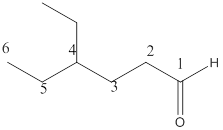
Therefore, the name of the compound becomes 4-ethylhexanal.
(c)
Interpretation:
The name of the following aldehyde is to be determined.
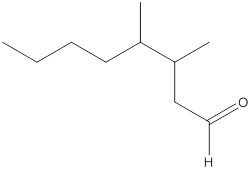
Concept Introduction:
While naming the aldehydes as per the IUPAC nomenclature, the naming of the compounds is done by adding a suffix-al in the end of the name. Firstly, one will find the longest chain that contains the -CHO group and then change the -e ending of the parent alkane chain to -al suffix. Then, the numbering of the chain or the ring is done in such a way so as to put the -CHO group at carbon no. 1 followed by omitting this number from the name. Thereafter, apply all other rules of nomenclature as usual.
Answer to Problem 22P
The name of the compound is 3,4-dimethyloctanal.
Explanation of Solution
The given molecular formula of the aldehyde is:
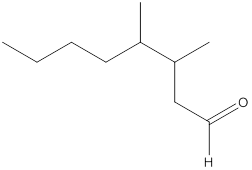
Here, the numbering of the carbon chain will start from the right where -CHO group is present. It can be clearly seen that the longest carbon chain containing the aldehyde group consists of eight carbon atoms and a methyl substituent is attached to carbon number 3 as well as carbon number 4.
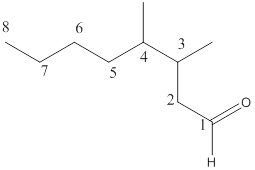
Therefore, the name of the compound becomes 3,4-dimethyloctanal.
(d)
Interpretation:
The name of the following aldehyde is to be determined.
Concept Introduction:
While naming the aldehydes as per the IUPAC nomenclature, the naming of the compounds is done by adding a suffix-al in the end of the name. Firstly, one will find the longest chain that contains the -CHO group and then change the -e ending of the parent alkane chain to -al suffix. Then, the numbering of the chain or the ring is done in such a way so as to put the -CHO group at carbon number 1 followed by omitting this number from the name. Thereafter, apply all other rules of nomenclature as usual.
Answer to Problem 22P
The name of the compound is 3-butylheptanal.
Explanation of Solution
The given molecular formula of the aldehyde can be written as follows:
Here, the numbering of the carbon chain will start from the right where -CHO group is present. It can be clearly seen that the longest carbon chain containing the aldehyde group consists of seven carbon atoms and abutyl substituent is attached to carbon number 3.
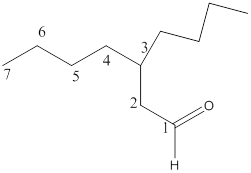
Therefore, the name of the compound becomes 3-butylheptanal.
(e)
Interpretation:
The name of the following aldehyde is to be determined.
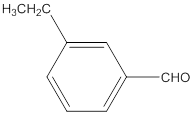
Concept Introduction:
While naming the aldehydes as per the IUPAC nomenclature, the naming of the compounds is done by adding a suffix-al in the end of the name. Firstly, one will find the longest chain that contains the -CHO group and then change the -e ending of the parent alkane chain to -al suffix. Then, the numbering of the chain or the ring is done in such a way so as to put the -CHO group at carbon no. 1 followed by omitting this number from the name. Thereafter, apply all other rules of nomenclature as usual.
Answer to Problem 22P
The name of the compound is 3-ethylbenzaldehyde.
Explanation of Solution
The given molecular formula of the aldehyde is:
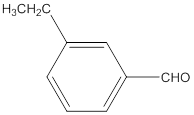
The name of the compound will be 3-ethylbenzaldehyde as the ethyl group is attached to the carbon number 3 of the parent molecule which is benzaldehyde. The benzene ring when attached to -CHO group is known as benzaldehyde.
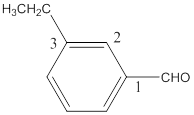
The naming of the molecule will start from the carbon to which aldehydic group is attached.
Want to see more full solutions like this?
Chapter 16 Solutions
General, Organic, and Biological Chemistry - 4th edition
- Protecting Groups and Carbonyls 6) The synthesis generates allethrolone that exhibits high insect toxicity but low mammalian toxicity. They are used in pet shampoo, human lice shampoo, and industrial sprays for insects and mosquitos. Propose detailed mechanistic steps to generate the allethrolone label the different types of reagents (Grignard, acid/base protonation, acid/base deprotonation, reduction, oxidation, witting, aldol condensation, Robinson annulation, etc.) III + VI HS HS H+ CH,CH,Li III I II IV CI + P(Ph)3 V ༼ Hint: no strong base added VI S VII IX HO VIII -MgBr HgCl2,HgO HO. isomerization aqeuous solution H,SO, ༽༽༤༽༽ X MeOH Hint: enhances selectivity for reaction at the S X ☑arrow_forwardDraw the complete mechanism for the acid-catalyzed hydration of this alkene. esc 田 Explanation Check 1 888 Q A slock Add/Remove step Q F4 F5 F6 A བྲA F7 $ % 5 @ 4 2 3 & 6 87 Click and drag to start drawing a structure. © 2025 McGraw Hill LLC. All Rights Reserved. Terms of Use | Privacy Ce W E R T Y U S D LL G H IK DD 요 F8 F9 F10 F1 * ( 8 9 0 O P J K L Z X C V B N M H He commandarrow_forwardExplanation Check F1 H₂O H₂ Pd 1) MCPBA 2) H3O+ 1) Hg(OAc)2, H₂O 2) NaBH4 OH CI OH OH OH hydration halohydrin formation addition halogenation hydrogenation inhalation hydrogenation hydration ☐ halohydrin formation addition halogenation formation chelation hydrogenation halohydrin formation substitution hydration halogenation addition Ohalohydrin formation subtraction halogenation addition hydrogenation hydration F2 80 F3 σ F4 F5 F6 1 ! 2 # 3 $ 4 % 05 Q W & Å © 2025 McGraw Hill LLC. All Rights Reserved. F7 F8 ( 6 7 8 9 LU E R T Y U A F9arrow_forward
- Show the mechanism steps to obtain the lowerenergy intermediate: *see imagearrow_forwardSoap is made by the previous reaction *see image. The main difference between one soap and another soap isthe length (number of carbons) of the carboxylic acid. However, if a soap irritates your skin, they mostlikely used too much lye.Detergents have the same chemical structure as soaps except for the functional group. Detergentshave sulfate (R-SO4H) and phosphate (R-PO4H2) functional groups. Draw the above carboxylic acidcarbon chain but as the two variants of detergents. *see imagearrow_forwardWhat are the reactions or reagents used? *see imagearrow_forward
- The two pKa values of oxalic acid are 1.25 and 3.81. Why are they not the same value? Show the protontransfer as part of your explanation. *see imagearrow_forwardасть Identify all the bonds that gauche interact with C-OMe in the most stable conformation of the above compound.arrow_forwardPredict the reactants used in the formation of the following compounds using Acid-Catalyzed dehydration reactionarrow_forward
- Chemistry: Matter and ChangeChemistryISBN:9780078746376Author:Dinah Zike, Laurel Dingrando, Nicholas Hainen, Cheryl WistromPublisher:Glencoe/McGraw-Hill School Pub Co
 ChemistryChemistryISBN:9781305957404Author:Steven S. Zumdahl, Susan A. Zumdahl, Donald J. DeCostePublisher:Cengage Learning
ChemistryChemistryISBN:9781305957404Author:Steven S. Zumdahl, Susan A. Zumdahl, Donald J. DeCostePublisher:Cengage Learning Chemistry: An Atoms First ApproachChemistryISBN:9781305079243Author:Steven S. Zumdahl, Susan A. ZumdahlPublisher:Cengage Learning
Chemistry: An Atoms First ApproachChemistryISBN:9781305079243Author:Steven S. Zumdahl, Susan A. ZumdahlPublisher:Cengage Learning 
 Chemistry & Chemical ReactivityChemistryISBN:9781337399074Author:John C. Kotz, Paul M. Treichel, John Townsend, David TreichelPublisher:Cengage Learning
Chemistry & Chemical ReactivityChemistryISBN:9781337399074Author:John C. Kotz, Paul M. Treichel, John Townsend, David TreichelPublisher:Cengage Learning Chemistry & Chemical ReactivityChemistryISBN:9781133949640Author:John C. Kotz, Paul M. Treichel, John Townsend, David TreichelPublisher:Cengage Learning
Chemistry & Chemical ReactivityChemistryISBN:9781133949640Author:John C. Kotz, Paul M. Treichel, John Townsend, David TreichelPublisher:Cengage Learning





